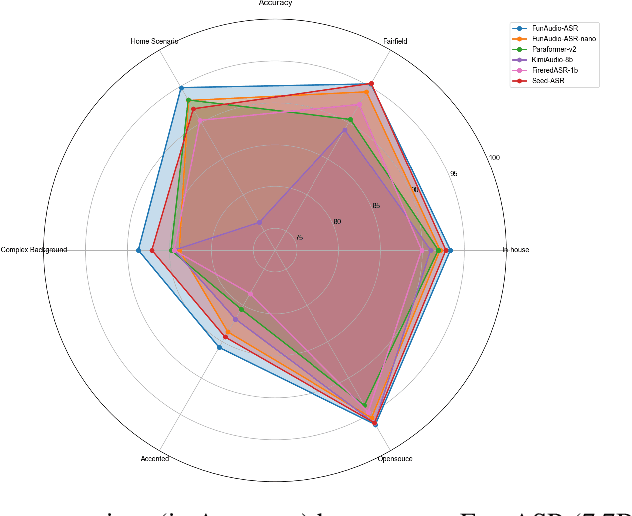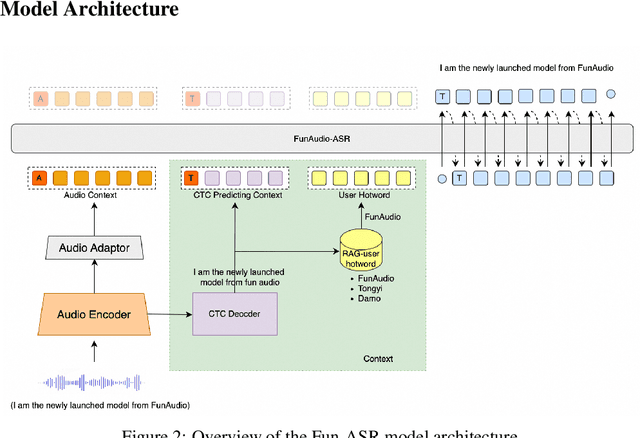Shengkui Zhao
FunAudio-ASR Technical Report
Sep 15, 2025



Abstract:In recent years, automatic speech recognition (ASR) has witnessed transformative advancements driven by three complementary paradigms: data scaling, model size scaling, and deep integration with large language models (LLMs). However, LLMs are prone to hallucination, which can significantly degrade user experience in real-world ASR applications. In this paper, we present FunAudio-ASR, a large-scale, LLM-based ASR system that synergistically combines massive data, large model capacity, LLM integration, and reinforcement learning to achieve state-of-the-art performance across diverse and complex speech recognition scenarios. Moreover, FunAudio-ASR is specifically optimized for practical deployment, with enhancements in streaming capability, noise robustness, code-switching, hotword customization, and satisfying other real-world application requirements. Experimental results show that while most LLM-based ASR systems achieve strong performance on open-source benchmarks, they often underperform on real industry evaluation sets. Thanks to production-oriented optimizations, FunAudio-ASR achieves SOTA performance on real application datasets, demonstrating its effectiveness and robustness in practical settings.
ClearerVoice-Studio: Bridging Advanced Speech Processing Research and Practical Deployment
Jun 24, 2025Abstract:This paper introduces ClearerVoice-Studio, an open-source, AI-powered speech processing toolkit designed to bridge cutting-edge research and practical application. Unlike broad platforms like SpeechBrain and ESPnet, ClearerVoice-Studio focuses on interconnected speech tasks of speech enhancement, separation, super-resolution, and multimodal target speaker extraction. A key advantage is its state-of-the-art pretrained models, including FRCRN with 3 million uses and MossFormer with 2.5 million uses, optimized for real-world scenarios. It also offers model optimization tools, multi-format audio support, the SpeechScore evaluation toolkit, and user-friendly interfaces, catering to researchers, developers, and end-users. Its rapid adoption attracting 3000 GitHub stars and 239 forks highlights its academic and industrial impact. This paper details ClearerVoice-Studio's capabilities, architectures, training strategies, benchmarks, community impact, and future plan. Source code is available at https://github.com/modelscope/ClearerVoice-Studio.
Plug-and-Play Co-Occurring Face Attention for Robust Audio-Visual Speaker Extraction
May 27, 2025Abstract:Audio-visual speaker extraction isolates a target speaker's speech from a mixture speech signal conditioned on a visual cue, typically using the target speaker's face recording. However, in real-world scenarios, other co-occurring faces are often present on-screen, providing valuable speaker activity cues in the scene. In this work, we introduce a plug-and-play inter-speaker attention module to process these flexible numbers of co-occurring faces, allowing for more accurate speaker extraction in complex multi-person environments. We integrate our module into two prominent models: the AV-DPRNN and the state-of-the-art AV-TFGridNet. Extensive experiments on diverse datasets, including the highly overlapped VoxCeleb2 and sparsely overlapped MISP, demonstrate that our approach consistently outperforms baselines. Furthermore, cross-dataset evaluations on LRS2 and LRS3 confirm the robustness and generalizability of our method.
HiFi-SR: A Unified Generative Transformer-Convolutional Adversarial Network for High-Fidelity Speech Super-Resolution
Jan 17, 2025Abstract:The application of generative adversarial networks (GANs) has recently advanced speech super-resolution (SR) based on intermediate representations like mel-spectrograms. However, existing SR methods that typically rely on independently trained and concatenated networks may lead to inconsistent representations and poor speech quality, especially in out-of-domain scenarios. In this work, we propose HiFi-SR, a unified network that leverages end-to-end adversarial training to achieve high-fidelity speech super-resolution. Our model features a unified transformer-convolutional generator designed to seamlessly handle both the prediction of latent representations and their conversion into time-domain waveforms. The transformer network serves as a powerful encoder, converting low-resolution mel-spectrograms into latent space representations, while the convolutional network upscales these representations into high-resolution waveforms. To enhance high-frequency fidelity, we incorporate a multi-band, multi-scale time-frequency discriminator, along with a multi-scale mel-reconstruction loss in the adversarial training process. HiFi-SR is versatile, capable of upscaling any input speech signal between 4 kHz and 32 kHz to a 48 kHz sampling rate. Experimental results demonstrate that HiFi-SR significantly outperforms existing speech SR methods across both objective metrics and ABX preference tests, for both in-domain and out-of-domain scenarios (https://github.com/modelscope/ClearerVoice-Studio).
Conditional Latent Diffusion-Based Speech Enhancement Via Dual Context Learning
Jan 17, 2025Abstract:Recently, the application of diffusion probabilistic models has advanced speech enhancement through generative approaches. However, existing diffusion-based methods have focused on the generation process in high-dimensional waveform or spectral domains, leading to increased generation complexity and slower inference speeds. Additionally, these methods have primarily modelled clean speech distributions, with limited exploration of noise distributions, thereby constraining the discriminative capability of diffusion models for speech enhancement. To address these issues, we propose a novel approach that integrates a conditional latent diffusion model (cLDM) with dual-context learning (DCL). Our method utilizes a variational autoencoder (VAE) to compress mel-spectrograms into a low-dimensional latent space. We then apply cLDM to transform the latent representations of both clean speech and background noise into Gaussian noise by the DCL process, and a parameterized model is trained to reverse this process, conditioned on noisy latent representations and text embeddings. By operating in a lower-dimensional space, the latent representations reduce the complexity of the generation process, while the DCL process enhances the model's ability to handle diverse and unseen noise environments. Our experiments demonstrate the strong performance of the proposed approach compared to existing diffusion-based methods, even with fewer iterative steps, and highlight the superior generalization capability of our models to out-of-domain noise datasets (https://github.com/modelscope/ClearerVoice-Studio).
Emotional Dimension Control in Language Model-Based Text-to-Speech: Spanning a Broad Spectrum of Human Emotions
Sep 25, 2024Abstract:Current emotional text-to-speech (TTS) systems face challenges in mimicking a broad spectrum of human emotions due to the inherent complexity of emotions and limitations in emotional speech datasets and models. This paper proposes a TTS framework that facilitates control over pleasure, arousal, and dominance, and can synthesize a diversity of emotional styles without requiring any emotional speech data during TTS training. We train an emotional attribute predictor using only categorical labels from speech data, aligning with psychological research and incorporating anchored dimensionality reduction on self-supervised learning (SSL) features. The TTS framework converts text inputs into phonetic tokens via an autoregressive language model and uses pseudo-emotional dimensions to guide the parallel prediction of fine-grained acoustic details. Experiments conducted on the LibriTTS dataset demonstrate that our framework can synthesize speech with enhanced naturalness and a variety of emotional styles by effectively controlling emotional dimensions, even without the inclusion of any emotional speech during TTS training.
Towards Audio Codec-based Speech Separation
Jun 18, 2024Abstract:Recent improvements in neural audio codec (NAC) models have generated interest in adopting pre-trained codecs for a variety of speech processing applications to take advantage of the efficiencies gained from high compression, but these have yet been applied to the speech separation (SS) task. SS can benefit from high compression because the compute required for traditional SS models makes them impractical for many edge computing use cases. However, SS is a waveform-masking task where compression tends to introduce distortions that severely impact performance. Here we propose a novel task of Audio Codec-based SS, where SS is performed within the embedding space of a NAC, and propose a new model, Codecformer, to address this task. At inference, Codecformer achieves a 52x reduction in MAC while producing separation performance comparable to a cloud deployment of Sepformer. This method charts a new direction for performing efficient SS in practical scenarios.
Phonetic Enhanced Language Modeling for Text-to-Speech Synthesis
Jun 04, 2024Abstract:Recent language model-based text-to-speech (TTS) frameworks demonstrate scalability and in-context learning capabilities. However, they suffer from robustness issues due to the accumulation of errors in speech unit predictions during autoregressive language modeling. In this paper, we propose a phonetic enhanced language modeling method to improve the performance of TTS models. We leverage self-supervised representations that are phonetically rich as the training target for the autoregressive language model. Subsequently, a non-autoregressive model is employed to predict discrete acoustic codecs that contain fine-grained acoustic details. The TTS model focuses solely on linguistic modeling during autoregressive training, thereby reducing the error propagation that occurs in non-autoregressive training. Both objective and subjective evaluations validate the effectiveness of our proposed method.
MossFormer2: Combining Transformer and RNN-Free Recurrent Network for Enhanced Time-Domain Monaural Speech Separation
Dec 19, 2023



Abstract:Our previously proposed MossFormer has achieved promising performance in monaural speech separation. However, it predominantly adopts a self-attention-based MossFormer module, which tends to emphasize longer-range, coarser-scale dependencies, with a deficiency in effectively modelling finer-scale recurrent patterns. In this paper, we introduce a novel hybrid model that provides the capabilities to model both long-range, coarse-scale dependencies and fine-scale recurrent patterns by integrating a recurrent module into the MossFormer framework. Instead of applying the recurrent neural networks (RNNs) that use traditional recurrent connections, we present a recurrent module based on a feedforward sequential memory network (FSMN), which is considered "RNN-free" recurrent network due to the ability to capture recurrent patterns without using recurrent connections. Our recurrent module mainly comprises an enhanced dilated FSMN block by using gated convolutional units (GCU) and dense connections. In addition, a bottleneck layer and an output layer are also added for controlling information flow. The recurrent module relies on linear projections and convolutions for seamless, parallel processing of the entire sequence. The integrated MossFormer2 hybrid model demonstrates remarkable enhancements over MossFormer and surpasses other state-of-the-art methods in WSJ0-2/3mix, Libri2Mix, and WHAM!/WHAMR! benchmarks.
SPGM: Prioritizing Local Features for enhanced speech separation performance
Sep 22, 2023



Abstract:Dual-path is a popular architecture for speech separation models (e.g. Sepformer) which splits long sequences into overlapping chunks for its intra- and inter-blocks that separately model intra-chunk local features and inter-chunk global relationships. However, it has been found that inter-blocks, which comprise half a dual-path model's parameters, contribute minimally to performance. Thus, we propose the Single-Path Global Modulation (SPGM) block to replace inter-blocks. SPGM is named after its structure consisting of a parameter-free global pooling module followed by a modulation module comprising only 2% of the model's total parameters. The SPGM block allows all transformer layers in the model to be dedicated to local feature modelling, making the overall model single-path. SPGM achieves 22.1 dB SI-SDRi on WSJ0-2Mix and 20.4 dB SI-SDRi on Libri2Mix, exceeding the performance of Sepformer by 0.5 dB and 0.3 dB respectively and matches the performance of recent SOTA models with up to 8 times fewer parameters.
 Add to Chrome
Add to Chrome Add to Firefox
Add to Firefox Add to Edge
Add to Edge